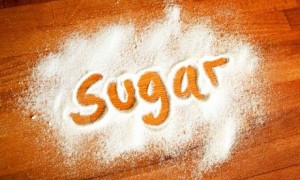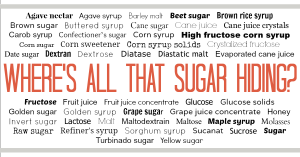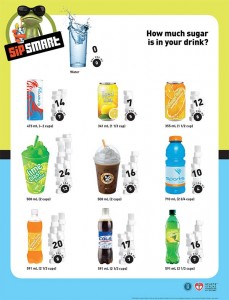How much sugar is too much? Added sugars, or those sugars added to prepared and processed foods, should only make up about 10% of an individual’s total calories per day. In fact, consuming less than 5% of your total calories from added sugars seems to provide additional health benefits, according to guidelines from the World Health Organization (WHO). Based on a 2,000-per day diet, this equates to only about 100 calories per day from added sugar.

However, recent data indicates that the average American consumes nearly 15% of their daily calories from added sugars; 3 times the recommended amount.
So, how do you reduce your sugar intake? Here are some helpful things to know about added sugars in foods and beverages.
Carbohydrates, like sugar, contain 4 calories/gram. 4 grams = 1 teaspoon of sugar. That means an adult with a normal body mass index (BMI), can consume about 25 grams, or about 6 teaspoons, of sugar per day.
Since one of the largest sources of added sugars for children and adults is sugar-sweetened beverages, let’s look at the sugar in a can of soda. A typical 12-oz can of cola contains 39 grams, or nearly 10 teaspoons, of sugar. That’s approximately 140 calories from sugar –well above the 100 calorie target.
The above poster from the “Sip Smart” program illustrates how one beverage alone usually far exceeds the daily recommended sugar calorie limit. And keep in mind that people who consume liquid sugars generally do not compensate by reducing caloric intake from other foods. Water (without sweeteners), of course, contains zero calories and is a much healthier choice.
There are over 200 different names for sugar in food ingredient lists. Terms for sugar include: sugar, corn syrup, honey, evaporated cane juice, molasses, dextrin, white grape juice concentrate, and sweet sorghum syrup. In general, ingredients that end in –ose, such as dextrose, sucrose, crystalline fructose, and maltose are sugars.

It can be difficult to know which foods contain sugar and how much of the sugar is hidden in processed foods. Check food labels for total grams of sugars, and divide that number by 4 to calculate how many teaspoons of sugar you will consume in each serving. Remember, your goal is a TOTAL of 6 teaspoons or less each day.
Decreasing sugar consumption can help maintain a healthy weight and reduce the risk of heart disease, diabetes and other obesity-related health problems. Why not start today? And if you are looking for a good place to start, before you reach for a sweetened beverage, remember to choose “water first for thirst”.


